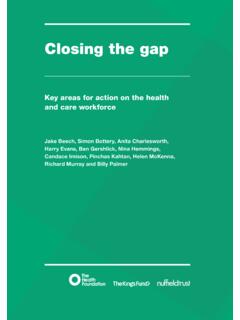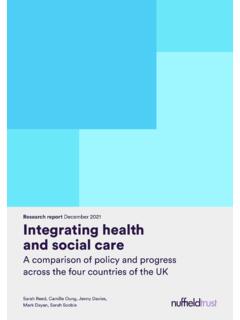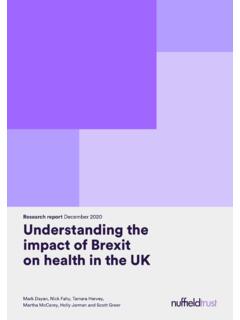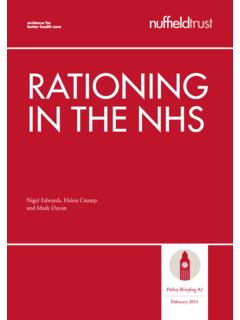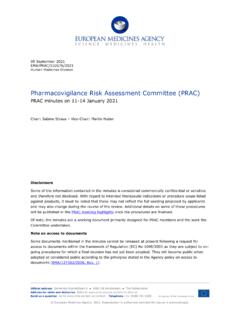Transcription of The structure of the NHS in England - The Nuffield Trust
1 | | | @commonslibrary BRIEFING PAPER Number CBP 07206, 10 March 2016 The structure of the NHS in England By Thomas Powell Inside: 1. Background 2. Commissioning 3. Access to treatment 4. Regulation and accountability 5. Competition and non-NHS providers 6. Public health services 7. Health and Wellbeing boards and Healthwatch 8. The future 9. Health services in Scotland, Wales and Northern Ireland 10. Further information Number CBP 07206, 10 March 2016 2 Contents Summary 3 1. Background 5 Funding 5 2. Commissioning 7 Clinical Commissioning Groups 7 NHS England 9 Duties of CCGs and NHS England 10 3. Access to treatment 11 NICE 11 The Cancer Drugs Fund 11 4.
2 Regulation and accountability 14 Monitor 14 The Care Quality Commission 14 The NHS Trust Development Authority 14 The Secretary of State for Health 15 The Health Select Committee 16 5. Competition and non-NHS providers 17 6. Public health services 18 Public health and local government 18 Public Health England and directly commissioned services 19 7. Health and Wellbeing boards and Healthwatch 21 Health and Wellbeing Boards 21 Healthwatch England and local Healthwatch 21 8. The future 23 9. Health services in Scotland, Wales and Northern Ireland 26 Scotland 26 Wales 26 Northern Ireland 27 10. Further information 28 Cover image copyright: Record shot by Ron Adams.
3 Licensed under CC BY / image cropped. 3 The structure of the NHS in England Summary Major reforms to the structure of the health service in England were introduced by the Health and Social Care Act 2012, with many provisions under the Act coming into force on 1 April 2013. This Library briefing provides an overview of the funding and accountability relationships under the new system, and an introduction to the roles of key organisations, including: NHS England and Clinical Commissioning Groups (CCGs) Monitor and the Care Quality Commission (CQC) and the regulation of health services Public Health England and local authorities public health duties Health and Wellbeing Boards and the co-ordination of health and social care services The National Institute for Health and Care Excellence (NICE) and access to treatment Several organisations have produced their own guides and diagrams explaining the structure of the NHS in England including the Department of Health, NHS England , the King's Fund, the National Audit Office, the BBC, and the All Party Health Group.
4 Below is a simplified diagram showing the pre- and post-reform structure of the NHS in England . Number CBP 07206, 10 March 2016 4 This briefing also highlights some of the key health policy issues for the current Parliament, including patient safety, funding, and the integration of health and social care. The House of Commons Library s Key Issues for the 2015 Parliament also contains sections on NHS funding and productivity and on integrating health and social care. Health policy is a largely devolved matter and this note is concerned with the structure of the NHS in England , however, a brief summary (with links to further information) on the health systems in the other parts of the UK is also included.
5 5 The structure of the NHS in England 1. Background The Health and Social Care Act 2012 introduced the most wide-ranging and controversial reform to the structure of the NHS since the service was established in 1948. The Act implemented the major reforms to the health service that were outlined in the July 2010 White Paper Equity and excellence: Liberating the NHS. This set out the 2010 Government s aims to reduce central control of the NHS, to engage doctors in the commissioning of health services, and to give patients greater choice. Many of the provisions under the 2012 Act came into force on 1 April 2013. This is when: NHS England and Clinical Commissioning Groups (CCGs) took on statutory responsibility for commissioning health services; local authorities took on new public health responsibilities; local Healthwatch organisations came into being; and strategic health authorities and primary care trusts were formally abolished.
6 Part 3 of the Care Act 2014 also established Health Education England (HEE) and the Health Research Authority (HRA) as statutory non-departmental bodies (NDPBs). This was intended to strengthen the independence of the two recently created bodies, which lead national systems for the education and training of health care professionals, and regulate health and social care research Funding Funding for health services comes from the total budget for the Department of Health (DH). In 2015/16 the total allocated budget for the DH is 115 billion for The majority of this budget ( billion) was transferred to NHS England with the remainder divided between DH s other agencies and programmes, including funding for Public Health England , and Arm s Length Bodies like the Care Quality Commission, Monitor and NICE.
7 NHS England s budget is used to deliver its mandate from the NHS England is responsible for allocating resources to local commissioners of health services: clinical commissioning groups (CCGs) and local authorities. Most of the commissioning resource allocations go to CCGs, billion in 2015/16. NHS England also directly commissions certain services on a national level for which it has a budget of billion in 2015/16, covering specialised services, primary care and military and offender services. The remainder of NHS England s budget is spent on centrally administered projects and services, including its public health 1 Further information about these can be found in the Library briefings on this Bill: Care Bill [HL] Commons Library Research Paper (December 2013), prepared for the Commons Second reading stage, and the Care Bill [HL] Committee Stage Report (March 2014).
8 2 HM Treasury, Public Expenditure Statistical Analyses 2014, Table 3 DH, A mandate from the Government to NHS England : April 2015 to March 2016, December 2014 Number CBP 07206, 10 March 2016 6 responsibilities on behalf of Public Health England , which broadly comprise immunisation, screening and health The table below shows the 2015/16 budget allocations for health in the constituent countries of the UK. In terms of budget per head of population, allocations in Northern Ireland are highest but it should be noted that its budget includes social care provision. England has the lowest budget allocation per head for health. 2015/16 Health Budgets billions Population (millions) Budget per head England 2,137 Northern Ireland* 2,569 Scotland 2,290 Wales 2,141 * budget includes social care funding Sources: HM Treasury: Public expenditure statistical analyses 2014, Table Scottish Government: Scotland's draft budget 2015/16 Welsh Government: Welsh Budget 2015/16 Northern Ireland Executive: Draft Budget 2015/16 ONS Mid-2013 population estimates 4 NHS England Business Plan 2015/16 7 The structure of the NHS in England 2.
9 Commissioning The Department of Health has defined commissioning as: The process of ensuring that the health and care services provided effectively meet the needs of the Commissioning is seen as a key means of helping achieve a wide range of policy objectives in the NHS, including improving the safety and quality of services; creating better value for money and wider patient choice; and reducing inequalities in health. Such objectives are partly achieved through allocating resources fairly among the population. How the resources are divided among the population is determined by a resource allocation funding formula. Library briefings Clinical Commissioning Group (CCG) Funding and NHS commissioning contain more information on the commissioning of NHS services.
10 Clinical Commissioning Groups On 1 April 2013, 212 Clinical Commissioning Groups (CCGs) took on statutory responsibilities for commissioning the majority of NHS services, including6: Urgent and emergency care (for example, A Elective hospital care (for example, outpatient services and elective surgery); Community health services (for example community mental health services and health visiting).7 The NHS s Five Year Forward View (October 2014) states that it intends progressively to offer CCGs more influence over the total NHS budget for their local populations, including greater responsibility for commissioning primary care and specialised services (See boxes 3 and 4).)
